Blockchain Enhanced Construction Waste Information Management: A Conceptual Framework
Abstract
:1. Introduction
2. Methodology
3. Results
3.1. Construction Waste Management (CWM)
3.1.1. Current CWM Practice
3.1.2. Current CWM Challenges
3.1.3. Current CWM Process
- Selecting the optimal construction scheme. The 3D model allows for the simulation of the shield excavation scheme [50];
- An evaluation on waste generation based on the optimal construction scheme. CIM facilitates the estimation of waste generation based on the previous project records and ground data [51], which helps in reducing waste generation;
- The assessment of construction waste quality. The chemical and environmental analysis of construction waste and the surrounding environment of the construction site is required to assess the waste quality and determine the waste composition, in which different construction techniques and geological factors affect the quality of the engineering residue [37];
- Waste recycling treatment. The process entails removing impurities from the waste that affect subsequent reuse. For example, tunnel mucks usually have a high iron content and a high solubility, which could be diminished by acid treatment and reduction roasting treatment so that it can be reused in construction, sanitary construction, and other industries;
- Physical–mechanical parameters and quality assessment. The treated material needs to undergo tests such as deformation modulus, mechanical resistance, strain and compressive strength, bulk density, water absorption, and whiteness. These test results must meet the requirements specified by national and international standards;
- Management of experimental data and material information, and;
- Selecting material transportation and storage plans.
3.1.4. Construction Waste Information Management
- Three-dimensional visualization. CIM intuitively and efficiently conveys information to users (stakeholders) by transforming information and data into three-dimensional image means to demonstrate the structure of the construction project [57];
- Simulation and data analysis. The CIM platform can be applied for construction schedule simulation, site analysis, and clash detection during CWM [10];
- Quantity calculation and waste estimation. Construction waste generation can be estimated in advance based on the information collected by the BIM-assisted platform, where the generated results provide guidance for the subsequent project construction [51];
- Information management. CIM integrates information into a unified platform for information management [59];
- Spatial query and analysis capabilities of GIS. CIM integrates the indoor and outdoor information of the city, including space, latitude, and longitude; as such, stakeholders can access and manage the spatial information of the city in the CIM platform [56]. Furthermore, CIM assists construction projects with waste quality assessments, in which the proportion and quality of the engineering residues produced during construction depend on the excavation techniques and the geological factors of the construction location [37]. Hence, construction techniques and geological conditions should be considered when recycling construction waste.
- Whole lifecycle control in construction projects. The integration of BIM and GIS achieves a digital representation of all aspects of the city to form a visible, operational, controllable, and predictable digital twin city [60]. Thus, the project planning and management process will leave traces on the CIM system that assists the visual control of the entire lifecycle in CWM.
3.2. The Challenges for City Information Management (CIM) Implementation in CWM
- 1.
- Technical challenges of CIM implementation:
- Lack of a framework and strategy for implementation. Currently, the application of CIM in CWM is still in its infancy, and as such it lacks a comprehensive and strategic framework for theoretical guidance [61];
- Interoperability of CIM. CIM is impeded by fragmented collaboration, which leads to incoherent and disjointed information due to the complexity of the data exchange between the information modeling software and projects [62]. In addition, tasks with different priorities bring difficulties in team communication and collaboration [63]. Therefore, the data need to be kept unaltered during the transmission process to create a CIM environment that facilitates business collaboration;
- Poor model quality and information asymmetry. There is an information gap in CWM, and the exchange of information between stakeholders is hindered, which has led to the predominance of waste disposal in landfills [63];
- Cyber security. Due to the rise of the sharing economy, CIM databases are threatened by theft and tampering [65].
- 2.
- Practical challenges faced by stakeholders:
- Extended responsibility and CIM contracts. Stakeholders such as clients, contractors, suppliers, and designers have the responsibility to reduce the generation of construction waste [66]. The unclear allocation of responsibilities between stakeholders is a key barrier in current CWM practice [67], in which the premise of waste recycling is to ensure that liability can be defined by contract;
- Intellectual property and value distribution. Value embodiment motivates stakeholders to participate in the recycling process of construction waste. Intellectual property is a prerequisite for the distribution of value, which not only increases the intrinsic motivation of designers, but also increases the motivation of related project stakeholders [68];
- Information model ownership management. Legal uncertainty is a major obstacle to BIM implementation. The implementation of CIM requires building trust between various stakeholders [69].
3.3. The Advantages and Potential Role of Blockchain for CIM Implementation in CWM
3.3.1. Blockchain Technology and Smart Contracts
3.3.2. Blockchain Networks
- 1.
- Public blockchain
- 2.
- Private blockchain
- 3.
- Consortium blockchain
3.3.3. Implementation Conditions of Blockchain Technology
- Multi-party data storage and update requirement. The transactions and operations performed by multiple stakeholders need to be recorded and stored.
- Consensus and validation requirement. When it is necessary to broadcast the affairs of stakeholders and to build trust between different parties, the actions and information of stakeholders need to go through a validation process and be documented.
- Time-limitations of transactions. The time delay of transactions will affect the project.
- Collaboration requirement. Transactions in projects are created by the interaction of multiple stakeholders and depend on their interactions.
3.3.4. The Potential of Blockchain to Overcome CIM Adoption Challenges in CWM
- Blockchain technology provides complete shared data to the users, and the information in the network is transparent to all users [87].
- Data in the blockchain network are encrypted and stored permanently, which greatly reduces the cost of information verification and improves network security. In the material supply chain, information such as material information usually requires the intervention of a trusted third-party intermediary to confirm whether the information is true. Therefore, users can query past information and verify the authenticity of the information without relying on a third party. This avoids the problem of high fees due to third-party information monitoring [88].
- Blockchain technology lessens the degree of information asymmetry. The authenticity of information verified by multiple parties is improved because of the large number of members on the blockchain [19]. This facilitates mutual supervision among multiple stakeholders.
- Blockchain technology addresses the ethical problems between enterprises, governments, and clients [89]. After the material information is uploaded on the blockchain, it is clear whether the enterprise has adopted green production technology.
4. The Conceptual Blockchain-Enhanced Construction Waste Management (BeCW) Framework
4.1. System Model
4.2. The BeCW Framework
4.2.1. High-Level Blockchain-Enhanced CIM for CWM (BeCW) Framework
- Brief and Design stage
- Construction stage
- Post-construction stage
4.2.2. Low-Level Blockchain-Enhanced CIM for CWM (BeCW) Framework
- Brief and Design stage
- a.
- Occurrence predictive model for the infrastructure such as construction sidewalks or heavy-duty sidewalks to be paved
- n: The number of construction areas;
- j: A construction area;
- S1j: The jth construction area (m2);
- S2j: The jth heavy-duty construction area (m2);
- hij: The average elevation of the jth construction area (m);
- h1j: The laying thickness of the jth construction area (m);
- h2j: The laying thickness of the jth heavy-duty construction area (m).
- b.
- Occurrence prediction model where it is impossible to determine whether temporary infrastructure is being constructed at the construction site
- 1.
- A: the length of the outer edge of the wall in the direction of the length of the building (m)
- 2.
- B: the length of the outer edge of the wall in the direction of the width of the building (m)
- 3.
- S: the ground floor area of the building (m2)
- 4.
- L: the perimeter of the outer edge of the building wall (m)
- 5.
- Construction stage
- 6.
- Post-construction stage
4.3. The Conceptual Architecture of User Level-Driven Blockchain-Enhanced CWM
5. Review and Refinement
5.1. Industry-Reviewed BeCW Framework
5.2. Refinement of the BeCW Framework
6. Discussion
6.1. Extended Transparency and Traceability of Information and Value Contribution of Stakeholders
6.2. Challenges of Blockchain-Enhanced CIM in MCWM
6.3. Theoretical and Practical Contributions
6.4. Future Work
7. Conclusions
- (1)
- A blockchain-based CWM system is proposed to provide a unified and trustworthy system for evaluating waste recyclability for stakeholders to identify information and aid the decisions process.
- (2)
- A comprehensive methodology that applies blockchain to CWM is proposed to support technical staff in the development of related software.
- (3)
- The BeCW framework is based on the consensus coordination process on WasteChain; waste information can be checked and audited by all consortium members to ensure the record authenticity.
Author Contributions
Funding
Institutional Review Board Statement
Informed Consent Statement
Data Availability Statement
Acknowledgments
Conflicts of Interest
References
- Cara, A. Horowitz Paris Agreement. Int. Leg. Mater. 2016, 55, 740–755. [Google Scholar]
- Greene, L.A. United Nations Framework Convention on Climate Change. Environ. Health Perspect. 2000, 108, A353. [Google Scholar] [CrossRef]
- European Commission. Closing the Loop—An EU Action Plan for the Circular Economy; European Commission: Brussels, Belgium, 2015. [Google Scholar]
- Barbosa, A.; Vallecillo, S.; Baranzelli, C.; Jacobs-Crisioni, C.; Batista e Silva, F.; Perpina-Castillo, C.; Lavalle, C.; Maes, J. Modelling Built-up Land Take in Europe to 2020: An Assessment of the Resource Efficiency Roadmap Measure on Land. J. Environ. Plan. Manag. 2017, 60, 1439–1463. [Google Scholar] [CrossRef]
- Lin, B.; Liu, H. CO2 Mitigation Potential in China’s Building Construction Industry: A Comparison of Energy Performance. Build. Environ. 2015, 94, 239–251. [Google Scholar] [CrossRef]
- Guo, W.; Wang, B.; Li, Y.; Mo, S. Status Quo and Prospect of Harmless Disposal and Reclamation of Shield Muck in China. Tunn. Constr. 2020, 40, 1101. [Google Scholar]
- Bellopede, R.; Marini, P. Aggregates from Tunnel Muck Treatments. Properties and Uses. Physicochem. Probl. Mineral Pro. 2011, 47, 259–266. [Google Scholar]
- Vatalis, K.I.; Manoliadis, O.; Charalampides, G.; Platias, S.; Savvidis, S. Sustainability Components Affecting Decisions for Green Building Projects. In Proceedings of the International Conference on Applied Economics (ICOAE), Istanbul, Turkey, 27–29 June 2013; Tsounis, N., Vlahvei, A., Eds.; Elsevier Science B.V.: Amsterdam, The Netherlands, 2013; Volume 5, pp. 747–756. [Google Scholar]
- Al-Mashhadani, A.E.S.; Qureshi, M.I.; Saad, S.S.H.M.S.M.; Vaicondam, Y.; Khan, N. Towards the Development of Digital Manufacturing Ecosystems for Sustainable Performance: Learning from the Past Two Decades of Research. Energies 2021, 14, 2945. [Google Scholar] [CrossRef]
- Liu, Z.; Osniani, M.; Demian, P.; Baldwin, A. A BIM-Aided Construction Waste Minimisation Framework. Autom. Constr. 2015, 59, 1–23. [Google Scholar] [CrossRef]
- Dantas, H.S.; Sousa, J.M.M.S.; Melo, H.C. The Importance of City Information Modeling (CIM) for Cities’ Sustainability. IOP Conf. Ser. Earth Environ. Sci. 2019, 225, 012074. [Google Scholar] [CrossRef]
- Nikolakis, W.; John, L.; Krishnan, H. How Blockchain Can Shape Sustainable Global Value Chains: An Evidence, Verifiability, and Enforceability (EVE) Framework. Sustainability 2018, 10, 3926. [Google Scholar] [CrossRef]
- Tseng, C.-T.; Shang, S.S.C. Exploring the Sustainability of the Intermediary Role in Blockchain. Sustainability 2021, 13, 1936. [Google Scholar] [CrossRef]
- Wei, C.; Li, Y. Design of Energy Consumption Monitoring and Energy-Saving Management System of Intelligent Building Based on the Internet of Things. In Proceedings of the 2011 International Conference on Electronics, Communications and Control (ICECC), Ningbo, China, 9–11 September 2011; IEEE: New York, NY, USA, 2011; pp. 3650–3652. [Google Scholar]
- Garcia-Muiña, F.E.; González-Sánchez, R.; Ferrari, A.M.; Volpi, L.; Pini, M.; Siligardi, C.; Settembre-Blundo, D. Identifying the Equilibrium Point between Sustainability Goals and Circular Economy Practices in an Industry 4.0 Manufacturing Context Using Eco-Design. Soc. Sci. 2019, 8, 241. [Google Scholar] [CrossRef]
- Cong, L.W.; He, Z.; Li, J. Decentralized Mining in Centralized Pools. Rev. Financ. Stud. 2021, 34, 1191–1235. [Google Scholar] [CrossRef]
- Biais, B.; Bisiere, C.; Bouvard, M.; Casamatta, C. The Blockchain Folk Theorem. Rev. Financ. Stud. 2019, 32, 1662–1715. [Google Scholar] [CrossRef]
- Chiu, J.; Koeppl, T.V. Blockchain-Based Settlement for Asset Trading. Rev. Financ. Stud. 2019, 32, 1716–1753. [Google Scholar] [CrossRef]
- Cong, L.W.; He, Z. Blockchain Disruption and Smart Contracts. Rev. Financ. Stud. 2019, 32, 1754–1797. [Google Scholar] [CrossRef]
- ISO/TR23244. Available online: http://www.bz52.com/app/home/productDetail/139d335963bb9332d01cc5159984e0f1 (accessed on 31 August 2022).
- IEEE Blockchain Standard. Available online: https://sagroups.ieee.org/bdlsc/ (accessed on 31 August 2022).
- JR/T 0184-2020. Available online: https://hbba.sacinfo.org.cn/stdDetail/b9b7db05fbfad9759abb01767da49fdf3cc1e42303be14714492e37e5d26f637 (accessed on 31 August 2022).
- JR/T 0193-2020. Available online: https://hbba.sacinfo.org.cn/stdDetail/32cb038f326c615f4196b7f3df170cfdec9d4fb69c16ab6f06a788e6d4632e34 (accessed on 31 August 2022).
- ISO/TS 23635:2022. Available online: https://www.iso.org/cms/render/live/en/sites/isoorg/contents/data/standard/07/64/76480.html (accessed on 31 August 2022).
- Kochovski, P.; Stankovski, V. Building Applications for Smart and Safe Construction with the DECENTER Fog Computing and Brokerage Platform. Autom. Constr. 2021, 124, 103562. [Google Scholar] [CrossRef]
- Website of China Society of Industrial and Applied Mathematics (csiam. Org. CN). Available online: https://www.csiam.org.cn/home/article/detail/id/1532.html (accessed on 26 May 2022).
- Jones, P.; Chalmers, L.; Wells, S.; Ameratunga, S.; Carswell, P.; Ashton, T.; Curtis, E.; Reid, P.; Stewart, J.; Harper, A.; et al. Implementing Performance Improvement in New Zealand Emergency Departments: The Six Hour Time Target Policy National Research Project Protocol. BMC Health Serv. Res. 2012, 12, 45. [Google Scholar] [CrossRef]
- Morse, J.M. Critical Analysis of Strategies for Determining Rigor in Qualitative Inquiry. Qual. Health Res. 2015, 25, 1212–1222. [Google Scholar] [CrossRef]
- Forero, R.; Nahidi, S.; De Costa, J.; Mohsin, M.; Fitzgerald, G.; Gibson, N.; McCarthy, S.; Aboagye-Sarfo, P. Application of Four-Dimension Criteria to Assess Rigour of Qualitative Research in Emergency Medicine. BMC Health Serv. Res. 2018, 18, 120. [Google Scholar] [CrossRef]
- Shojaei, A.; Ketabi, R.; Razkenari, M.; Hakim, H.; Wang, J. Enabling a Circular Economy in the Built Environment Sector through Blockchain Technology. J. Clean Prod. 2021, 294, 126352. [Google Scholar] [CrossRef]
- Wysokińska, Z. Implementing the Main Circular Economy Principles within the Concept of Sustainable Development in the Global and European Economy, with Particular Emphasis on Central and Eastern Europe—The Case of Poland and the Region of Lodz. Comp. Econ. Res. 2018, 21, 75–93. [Google Scholar] [CrossRef]
- Ghisellini, P.; Cialani, C.; Ulgiati, S. A Review on Circular Economy: The Expected Transition to a Balanced Interplay of Environmental and Economic Systems. J. Clean Prod. 2016, 114, 11–32. [Google Scholar] [CrossRef]
- Jacobsen, R.; Willeghems, G.; Gellynck, X.; Buysse, J. Increasing the Quantity of Separated Post-Consumer Plastics for Reducing Combustible Household Waste: The Case of Rigid Plastics in Flanders. Waste Manag. 2018, 78, 708–716. [Google Scholar] [CrossRef] [PubMed]
- Benachio, G.L.F.; Freitas, M.D.C.D.; Tavares, S.F. Circular Economy in the Construction Industry: A Systematic Literature Review. J. Clean. Prod. 2020, 260, 121046. [Google Scholar] [CrossRef]
- Liu, L.; Liang, Y.; Song, Q.; Li, J. A Review of Waste Prevention through 3R under the Concept of Circular Economy in China. J. Mater. Cycles Waste Manag. 2017, 19, 1314–1323. [Google Scholar] [CrossRef]
- Peng, C.-L.; Scorpio, D.E.; Kibert, C.J. Strategies for Successful Construction and Demolition Waste Recycling Operations. Constr. Manag. Econ. 1997, 15, 49–58. [Google Scholar] [CrossRef]
- Oggeri, C.; Fenoglio, T.M.; Vinai, R. Tunnel Spoil Classification and Applicability of Lime Addition in Weak Formations for Muck Reuse. Tunn. Undergr. Space Technol. 2014, 44, 97–107. [Google Scholar] [CrossRef]
- Liu, J.; Yi, Y.; Wang, X. Exploring Factors Influencing Construction Waste Reduction: A Structural Equation Modeling Approach. J. Clean Prod. 2020, 276, 123185. [Google Scholar] [CrossRef]
- Guerra, B.C.; Leite, F.; Faust, K.M. 4D-BIM to Enhance Construction Waste Reuse and Recycle Planning: Case Studies on Concrete and Drywall Waste Streams. Waste Manag. 2020, 116, 79–90. [Google Scholar] [CrossRef]
- Ding, Z.; Zhu, M.; Tam, V.W.Y.; Yi, G.; Tran, C.N.N. A System Dynamics-Based Environmental Benefit Assessment Model of Construction Waste Reduction Management at the Design and Construction Stages. J. Clean Prod. 2018, 176, 676–692. [Google Scholar] [CrossRef]
- A Comparative Study on Economic Instruments Promoting Waste Prevention—Eunomia. Available online: https://www.eunomia.co.uk/reports-tools/a-comparative-study-on-economic-instruments-promoting-waste-prevention-2/ (accessed on 31 August 2022).
- Bellopede Main Aspects of Tunnel Muck Recycling. Am. J. Environ. Sci. 2011, 7, 338–347. [CrossRef]
- Liu, J.; Gong, E.; Wang, D.; Lai, X.; Zhu, J. Attitudes and Behaviour towards Construction Waste Minimisation: A Comparative Analysis between China and the USA. Environ. Sci. Pollut. Res. 2019, 26, 13681–13690. [Google Scholar] [CrossRef] [PubMed]
- The Routemap for Zero Avoidable Waste in Construction. Available online: https://constructiondaily.news/routemap-to-zero-avoidable-waste-in-building/ (accessed on 3 September 2022).
- Manowong, E. Investigating Factors Influencing Construction Waste Management Efforts in Developing Countries: An Experience from Thailand. Waste Manag. Res. 2012, 30, 56–71. [Google Scholar] [CrossRef] [PubMed]
- Zhang, L.W.; Sojobi, A.O.; Kodur, V.K.R.; Liew, K.M. Effective Utilization and Recycling of Mixed Recycled Aggregates for a Greener Environment. J. Clean Prod. 2019, 236, 117600. [Google Scholar] [CrossRef]
- Gopalakrishnan, P.K.; Hall, J.; Behdad, S. Cost Analysis and Optimization of Blockchain-Based Solid Waste Management Traceability System. Waste Manag. 2021, 120, 594–607. [Google Scholar] [CrossRef]
- Cai, G.; Waldmann, D. A Material and Component Bank to Facilitate Material Recycling and Component Reuse for a Sustainable Construction: Concept and Preliminary Study. Clean Technol. Environ. Policy 2019, 21, 2015–2032. [Google Scholar] [CrossRef]
- Xu, X.; Ding, L.; Luo, H.; Ma, L. From Building Information Modeling to City Information Modeling. Electron. J. Inf. Technol. Constr. 2014, 19, 292–307. [Google Scholar]
- Bei, L.; Xianbin, S. Application Analysis of BIM Technology in Metro Rail Transit. In Proceedings of the 3rd International Conference on Energy Equipment Science and Engineering (ICEESE 2017), Haikou, China, 27–29 October 2017; Iop Publishing Ltd.: Bristol, UK, 2018; Volume 128, p. 012028. [Google Scholar]
- Guerra, B.C.; Bakchan, A.; Leite, F.; Faust, K.M. BIM-Based Automated Construction Waste Estimation Algorithms: The Case of Concrete and Drywall Waste Streams. Waste Manag. 2019, 87, 825–832. [Google Scholar] [CrossRef]
- Li, Y.-W.; Cao, K. Establishment and Application of Intelligent City Building Information Model Based on BP Neural Network Model. Comput. Commun. 2020, 153, 382–389. [Google Scholar] [CrossRef]
- Falcão, G.; Beirão, J. Design Narrative and City Information Modeling. In Proceedings of the Human Systems Engineering and Design III; Karwowski, W., Ahram, T., Etinger, D., Tanković, N., Taiar, R., Eds.; Springer International Publishing: Cham, Switzerland, 2021; pp. 142–147. [Google Scholar]
- Reitz, T.; Schubiger-Banz, S. The Esri 3D City Information Model. In Proceedings of the 8th International Symposium of the Digital Earth (ISDE8), Kutching, Malaysia, 26–29 August 2013; Iop Publishing Ltd.: Bristol, UK, 2014; Volume 18, p. 012172. [Google Scholar]
- Yosino, C.M.O.; Ferreira, S.L. Using BIM and GIS Interoperability to Create CIM Model for USW Collection Analysis. In Proceedings of the 18th International Conference on Computing in Civil and Building Engineering, São Paulo, Brazil, 18–20 August 2020; Toledo Santos, E., Scheer, S., Eds.; Lecture Notes in Civil Engineering. Springer International Publishing: Cham, Switzerland, 2021; Volume 98, pp. 248–271, ISBN 978-3-030-51294-1. [Google Scholar]
- Melo, H.C.; Tomé, S.M.G.; Silva, M.H.; Gonzales, M.M.; Gomes, D.B.O. Implementation of City Information Modeling (CIM) Concepts in the Process of Management of the Sewage System in Piumhi, Brazil. IOP Conf. Ser. Earth Environ. Sci. 2019, 225, 012076. [Google Scholar] [CrossRef]
- Li, X.; Xu, J.; Zhang, Q. Research on Construction Schedule Management Based on BIM Technology. In Proceedings of the 13th Global Congress on Manufacturing and Management, Zhengzhou, China, 28–30 November 2016; Yeh, W.C., Zhao, L., Eds.; Elsevier Science B.V.: Amsterdam, The Netherlands, 2017; Volume 174, pp. 657–667. [Google Scholar]
- Ghaffarianhoseini, A.; Tookey, J.; Ghaffarianhoseini, A.; Naismith, N.; Azhar, S.; Efimova, O.; Raahemifar, K. Building Information Modelling (BIM) Uptake: Clear Benefits, Understanding Its Implementation, Risks and Challenges. Renew. Sust. Energ. Rev. 2017, 75, 1046–1053. [Google Scholar] [CrossRef]
- Xue, F.; Wu, L.; Lu, W. Semantic Enrichment of Building and City Information Models: A Ten-Year Review. Adv. Eng. Inform. 2021, 47, 101245. [Google Scholar] [CrossRef]
- Zhu, J.; Wu, P. Towards Effective BIM/GIS Data Integration for Smart City by Integrating Computer Graphics Technique. Remote Sens. 2021, 13, 1889. [Google Scholar] [CrossRef]
- Thompson, E.M.; Greenhalgh, P.; Muldoon-Smith, K.; Charlton, J.; Dolnik, M. Planners in the Future City: Using City Information Modelling to Support Planners as Market Actors. Urban Plan. 2016, 1, 79–94. [Google Scholar] [CrossRef]
- Xue, F.; Lu, W. A Semantic Differential Transaction Approach to Minimizing Information Redundancy for BIM and Blockchain Integration. Autom. Constr. 2020, 118, 103270. [Google Scholar] [CrossRef]
- Nawari, N.O.; Ravindran, S. Blockchain and the Built Environment: Potentials and Limitations. J. Build. Eng. 2019, 25, 100832. [Google Scholar] [CrossRef]
- Khaddaj, M.; Srour, I. Using BIM to Retrofit Existing Buildings. In Proceedings of the Icsdec 2016—Integrating Data Science, Construction and Sustainability, Tempe, AZ, USA, 18–20 May 2016; Chong, O., Parrish, K., Tang, P., Grau, D., Chang, J., Eds.; Elsevier Science B.V.: Amsterdam, The Netherlands, 2016; Volume 145, pp. 1526–1533. [Google Scholar]
- Solihin, W.; Eastman, C. Classification of Rules for Automated BIM Rule Checking Development. Autom. Constr. 2015, 53, 69–82. [Google Scholar] [CrossRef]
- Osmani, M. Construction Waste Minimization in the UK: Current Pressures for Change and Approaches. In Proceedings of the Asia Pacific Business Innovation and Technology Management Society, Dalian, China, 10–12 July 2011; Chiu, A.S.F., Tseng, J.M.L., Wu, G.K.J., Eds.; Elsevier Science B.V.: Amsterdam, The Netherlands, 2012; Volume 40, pp. 37–40. [Google Scholar]
- Azhar, S.; Khalfan, M.M.A.; Maqsood, T. Building Information Modelling (BIM): Now and Beyond. Australas. J. Constr. Econ. Build. 2012, 12, 15–28. [Google Scholar] [CrossRef]
- Coyne, R.; Onabolu, T. Blockchain for Architects: Challenges from the Sharing Economy. Archit. Res. Q. 2017, 21, 369–374. [Google Scholar] [CrossRef]
- Chien, K.-F.; Wu, Z.-H.; Huang, S.-C. Identifying and Assessing Critical Risk Factors for BIM Projects: Empirical Study. Autom. Constr. 2014, 45, 1–15. [Google Scholar] [CrossRef]
- Akram, S.V.; Malik, P.K.; Singh, R.; Anita, G.; Tanwar, S. Adoption of Blockchain Technology in Various Realms: Opportunities and Challenges. Secur. Priv. 2020, 3, e109. [Google Scholar] [CrossRef]
- Garay, J.; Kiayias, A.; Leonardos, N. The Bitcoin Backbone Protocol: Analysis and Applications. In Proceedings of the Advances in Cryptology—Eurocrypt 2015, Pt Ii; Oswald, E., Fischlin, M., Eds.; Springer: Berlin, Germany, 2015; Volume 9057, pp. 281–310. [Google Scholar]
- Song, H.; Zhu, N.; Xue, R.; He, J.; Zhang, K.; Wang, J. Proof-of-Contribution Consensus Mechanism for Blockchain and Its Application in Intellectual Property Protection. Inf. Process. Manag. 2021, 58, 102507. [Google Scholar] [CrossRef]
- Lin, I.-C.; Liao, T.-C. A Survey of Blockchain Security Issues and Challenges. Int. J. Netw. Secur. 2017, 19, 653–659. [Google Scholar] [CrossRef]
- Macrinici, D.; Cartofeanu, C.; Gao, S. Smart Contract Applications within Blockchain Technology: A Systematic Mapping Study. Telemat. Inform. 2018, 35, 2337–2354. [Google Scholar] [CrossRef]
- Shojaei, A.; Flood, I.; Moud, H.I.; Hatami, M.; Zhang, X. An Implementation of Smart Contracts by Integrating BIM and Blockchain. In Proceedings of the Future Technologies Conference (FTC) 2019, Vol 2, San Francisco, CA, USA, 24–25 October 2019; Arai, K., Bhatia, R., Kapoor, S., Eds.; Springer International Publishing Ag: Cham, Switzerland, 2020; Volume 1070, pp. 519–527. [Google Scholar]
- Perera, S.; Nanayakkara, S.; Rodrigo, M.N.N.; Senaratne, S.; Weinand, R. Blockchain Technology: Is It Hype or Real in the Construction Industry? J. Ind. Inf. Integr. 2020, 17, 100125. [Google Scholar] [CrossRef]
- Ojo, A.; Adebayo, S. Blockchain as a Next Generation Government Information Infrastructure: A Review of Initiatives in D5 Countries; Springer: Berlin/Heidelberg, Germany, 2017. [Google Scholar]
- Jiang, T.; Fang, H.; Wang, H. Blockchain-Based Internet of Vehicles: Distributed Network Architecture and Performance Analysis. IEEE Internet Things J. 2019, 6, 4640–4649. [Google Scholar] [CrossRef]
- Lewis, R.; McPartland, J.; Ranjan, R. Blockchain and Financial Market Innovation. Econ. Perspect. 2019, 41, 1–17. [Google Scholar]
- Guegan, D. Public Blockchain versus Private Blockhain. Res. Pap. Econ. 2017. Available online: https://halshs.archives-ouvertes.fr/halshs-01524440 (accessed on 31 August 2022).
- Yang, R.; Wakefield, R.; Lyu, S.; Jayasuriya, S.; Han, F.; Yi, X.; Yang, X.; Amarasinghe, G.; Chen, S. Public and Private Blockchain in Construction Business Process and Information Integration. Autom. Constr. 2020, 118, 103276. [Google Scholar] [CrossRef]
- Li, Z.; Kang, J.; Yu, R.; Ye, D.; Deng, Q.; Zhang, Y. Consortium Blockchain for Secure Energy Trading in Industrial Internet of Things. IEEE Trans. Ind. Inform. 2018, 14, 3690–3700. [Google Scholar] [CrossRef]
- Anjum, A.; Sporny, M.; Sill, A. Blockchain Standards for Compliance and Trust. IEEE Cloud Comput. 2017, 4, 84–90. [Google Scholar] [CrossRef]
- Elghaish, F.; Abrishami, S.; Hosseini, M.R. Integrated Project Delivery with Blockchain: An Automated Financial System. Autom. Constr. 2020, 114, 103182. [Google Scholar] [CrossRef]
- Turk, Z.; Klinc, R. Potentials of Blockchain Technology for Construction Management. In Proceedings of the Creative Construction Conference 2017, CCC 2017, Primosten, Croatia, 19–22 June 2017; Hajdu, M., Skibniewski, M.E., Eds.; Elsevier Science B.V.: Amsterdam, The Netherlands, 2017; Volume 196, pp. 638–645. [Google Scholar]
- Kouhizadeh, M.; Zhu, Q.; Sarkis, J. Blockchain and the Circular Economy: Potential Tensions and Critical Reflections from Practice. Prod. Plan. Control. 2020, 31, 950–966. [Google Scholar] [CrossRef]
- Alexandris, G.; Katos, V.; Alexaki, S.; Hatzivasilis, G. Blockchains as Enablers for Auditing Cooperative Circular Economy Networks. In Proceedings of the 2018 IEEE 23rd International Workshop on Computer Aided Modeling and Design of Communication Links and Networks (CAMAD), Barcelona, Spain, 17–19 September 2018; IEEE: New York, NY, USA, 2018; pp. 247–253. [Google Scholar]
- Catalini, C.; Gans, J.S. Some Simple Economics of the Blockchain. Commun. ACM 2020, 63, 80–90. [Google Scholar] [CrossRef]
- Cai, Y.-J.; Choi, T.-M.; Zhang, J. Platform Supported Supply Chain Operations in the Blockchain Era: Supply Contracting and Moral Hazards. Decis. Sci. 2021, 52, 866–892. [Google Scholar] [CrossRef]
- Osmani, M. Design Waste Mapping: A Project Life Cycle Approach. Proc. Inst. Civ. Eng. —Waste Resour. Manag. 2013, 166, 114–127. [Google Scholar] [CrossRef]
- Abaglo, A.J.; Bonalda, C.; Pertusa, E. Environmental Digital Model: Integration of BIM into Environmental Building Simulations. In Proceedings of the Cisbat 2017 International Conference Future Buildings & Districts & Energy Efficiency from Nano to Urban Scale, Lausanne, Switzerland, 6–8 September 2017; Scartezzini, J.L., Ed.; Elsevier Science B.V.: Amsterdam, The Netherlands, 2017; Volume 122, pp. 1063–1068. [Google Scholar]
- Walasek, D.; Barszcz, A. Analysis of the Adoption Rate of Building Information Modeling [BIM] and Its Return on Investment. In Proceedings of the Modern Building Materials, Structures and Techniques, Amsterdam, The Netherlands, 21 February 2017; Juozapaitis, A., Daniunas, A., Zavadskas, E.K., Eds.; Elsevier Science B.V.: Amsterdam, The Netherlands, 2017; Volume 172, pp. 1227–1234. [Google Scholar]
- Bossink, B.A.G.; Brouwers, H.J.H. Construction Waste: Quantification and Source Evaluation. J. Constr. Eng. Manag. 1996, 122, 55–60. [Google Scholar] [CrossRef]
- Rounce, G. Quality, Waste and Cost Considerations in Architectural Building Design Management. Int. J. Proj. Manag. 1998, 16, 123–127. [Google Scholar] [CrossRef]
- Ge, X.J.; Livesey, P.; Wang, J.; Huang, S.; He, X.; Zhang, C. Deconstruction Waste Management through 3d Reconstruction and Bim: A Case Study. Vis. Eng. 2017, 5, 13. [Google Scholar] [CrossRef]
- Osmani, M.; Glass, J.; Price, A.D.F. Architects’ Perspectives on Construction Waste Reduction by Design. Waste Manag. 2008, 28, 1147–1158. [Google Scholar] [CrossRef]
- Faniran, O.O.; Caban, G. Minimizing Waste on Construction Project Sites. Eng. Constr. Archit. Manag. 1998, 5, 182–188. [Google Scholar] [CrossRef]
- Li, L.; Wang, L. Application of BIM Technology in Green Building Engineering Construction. In Energy Development, Pts 1–4; Xu, Q., Li, Y., Yang, X., Eds.; Trans Tech Publications Ltd.: Stafa-Zurich, Switzerland, 2014; Volume 860–863, pp. 1301–1305. [Google Scholar]
- Jia, J.; Sun, J.; Wang, Z.; Xu, T. The Construction of BIM Application Value System for Residential Buildings’ Design Stage in China Based on Traditional DBB Mode. In Proceedings of the International High-Performance Built Environment Conference—A Sustainable Built Environment Conference 2016 Series (SBE16), IHBE 2016, Sydney, Australia, 17–18 November 2016; Ding, L., Fiorito, F., Osmond, P., Eds.; Elsevier Science B.V.: Amsterdam, The Netherlands, 2017; Volume 180, pp. 851–858. [Google Scholar]
- Akbarieh, A.; Carbone, W.; Schäfer, M.; Waldmann, D.; Teferle, F.N. Extended Producer Responsibility in the Construction Sector through Blockchain, BIM and Smart Contract Technologies. World Congr. Sustain. Technol. 2020. [Google Scholar] [CrossRef]
- Shooshtarian, S.; Maqsood, T.; Wong, P.S.P.; Khalfan, M.; Yang, R.J. Extended Producer Responsibility in the Australian Construction Industry. Sustainability 2021, 13, 620. [Google Scholar] [CrossRef]
- Dakhli, Z.; Lafhaj, Z.; Mossman, A. The Potential of Blockchain in Building Construction. Buildings 2019, 9, 77. [Google Scholar] [CrossRef]
- Liu, C.; Zhang, X.; Medda, F. Plastic Credit: A Consortium Blockchain-Based Plastic Recyclability System. Waste Manag. 2021, 121, 42–51. [Google Scholar] [CrossRef] [PubMed]
- Bello, S.A.; Oyedele, L.O.; Akinade, O.O.; Bilal, M.; Delgado, J.M.D.; Akanbi, L.A.; Ajayi, A.O.; Owolabi, H.A. Cloud Computing in Construction Industry: Use Cases, Benefits and Challenges. Autom. Constr. 2021, 122, 103441. [Google Scholar] [CrossRef]
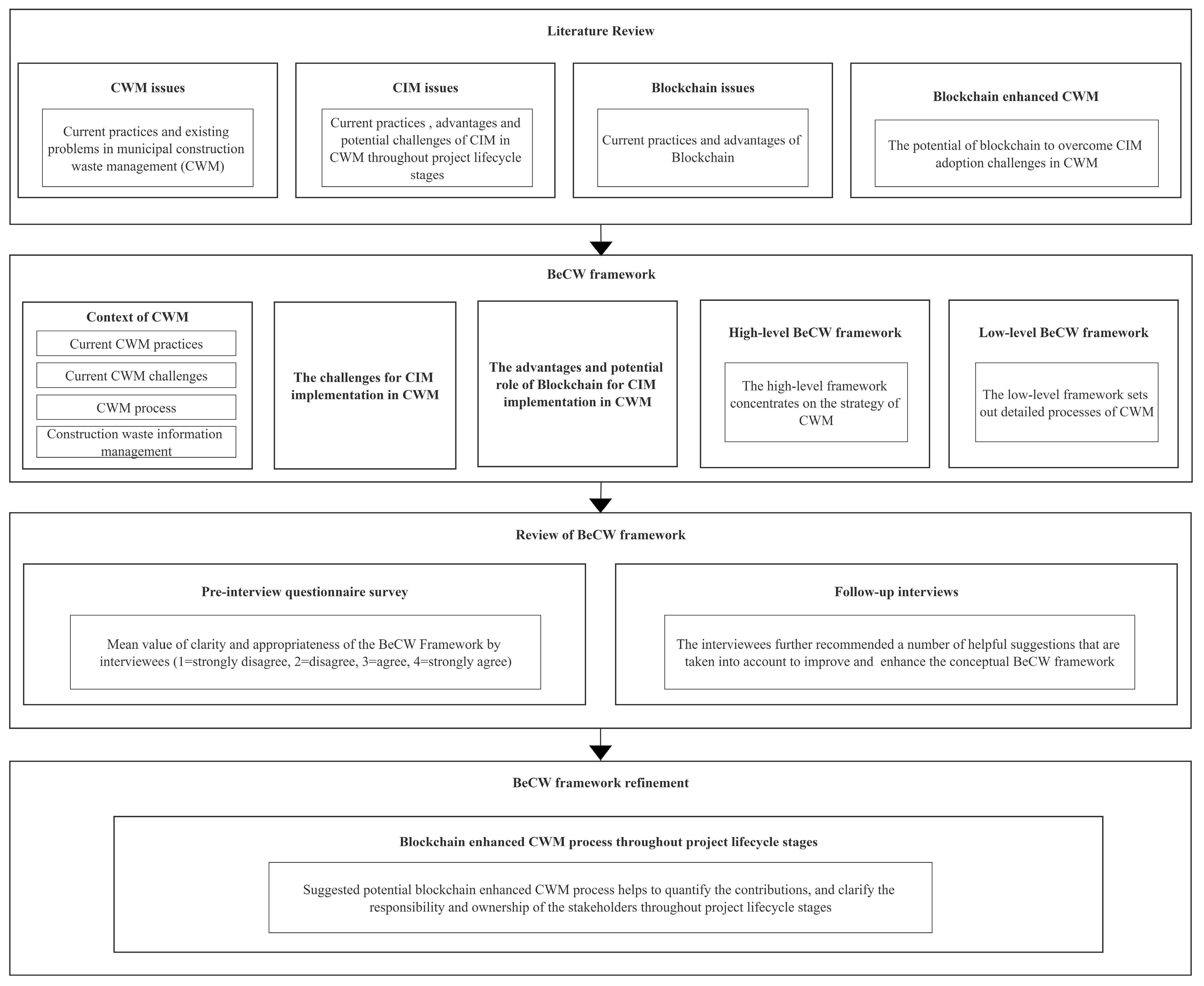
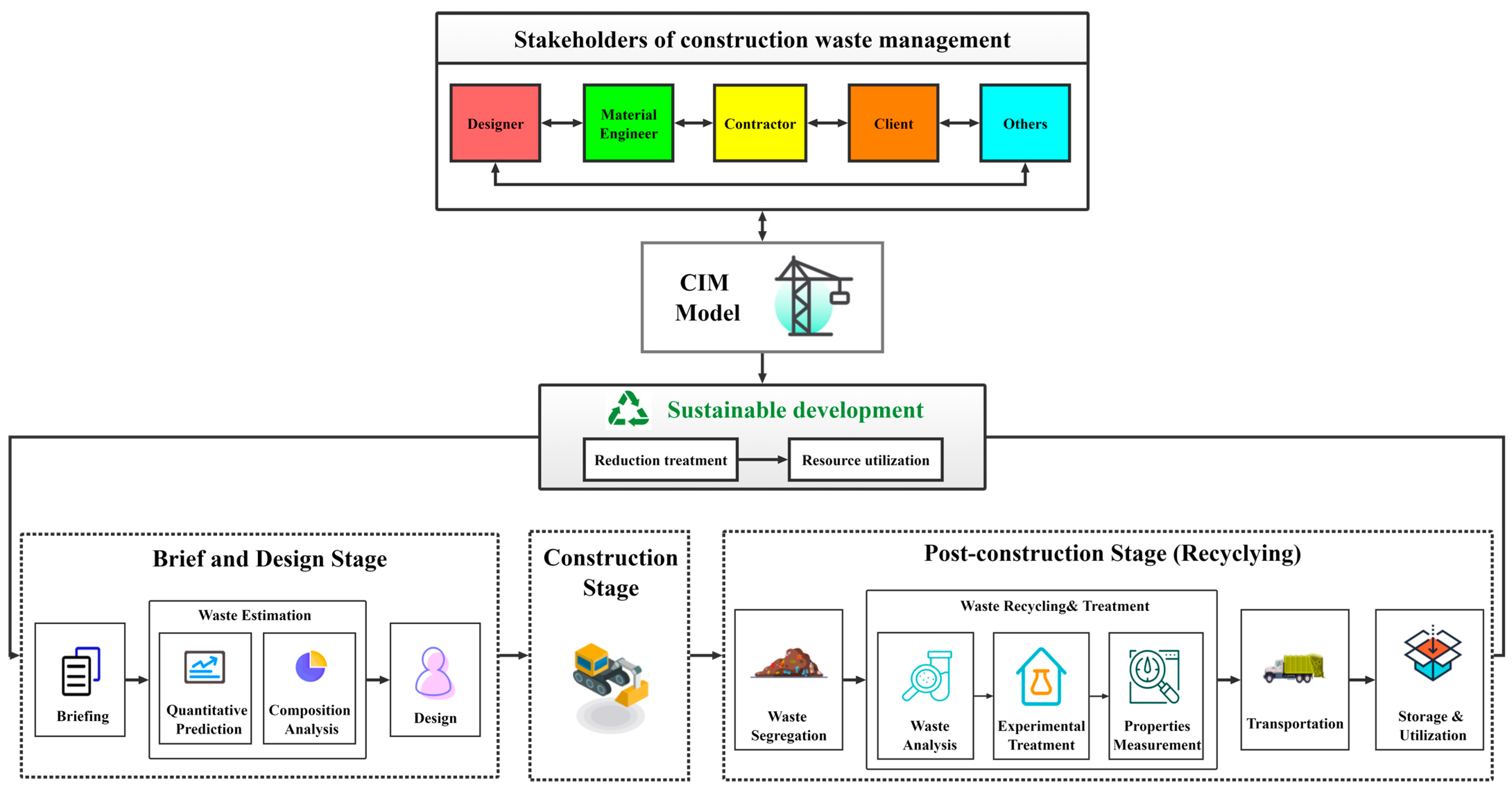
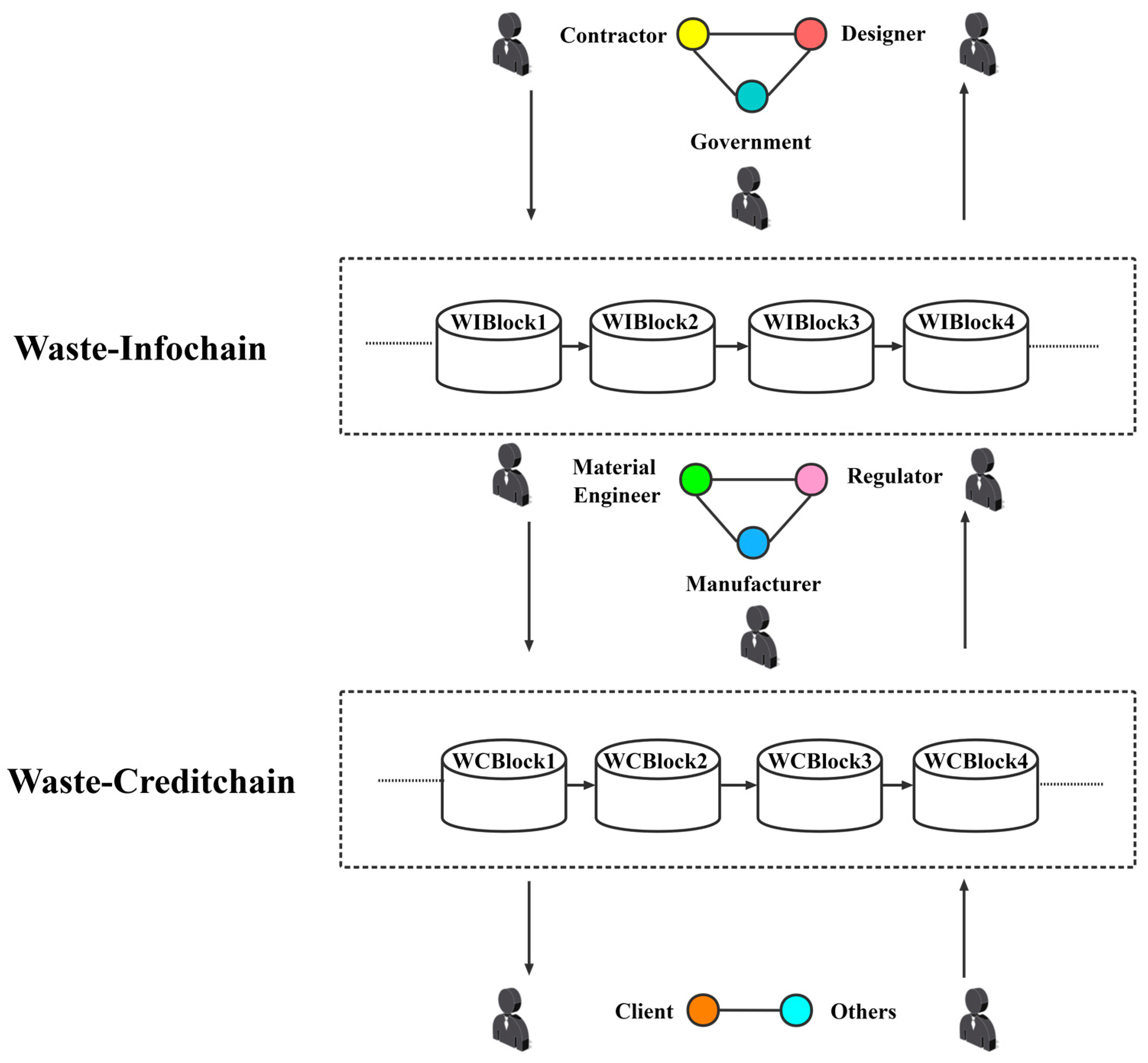

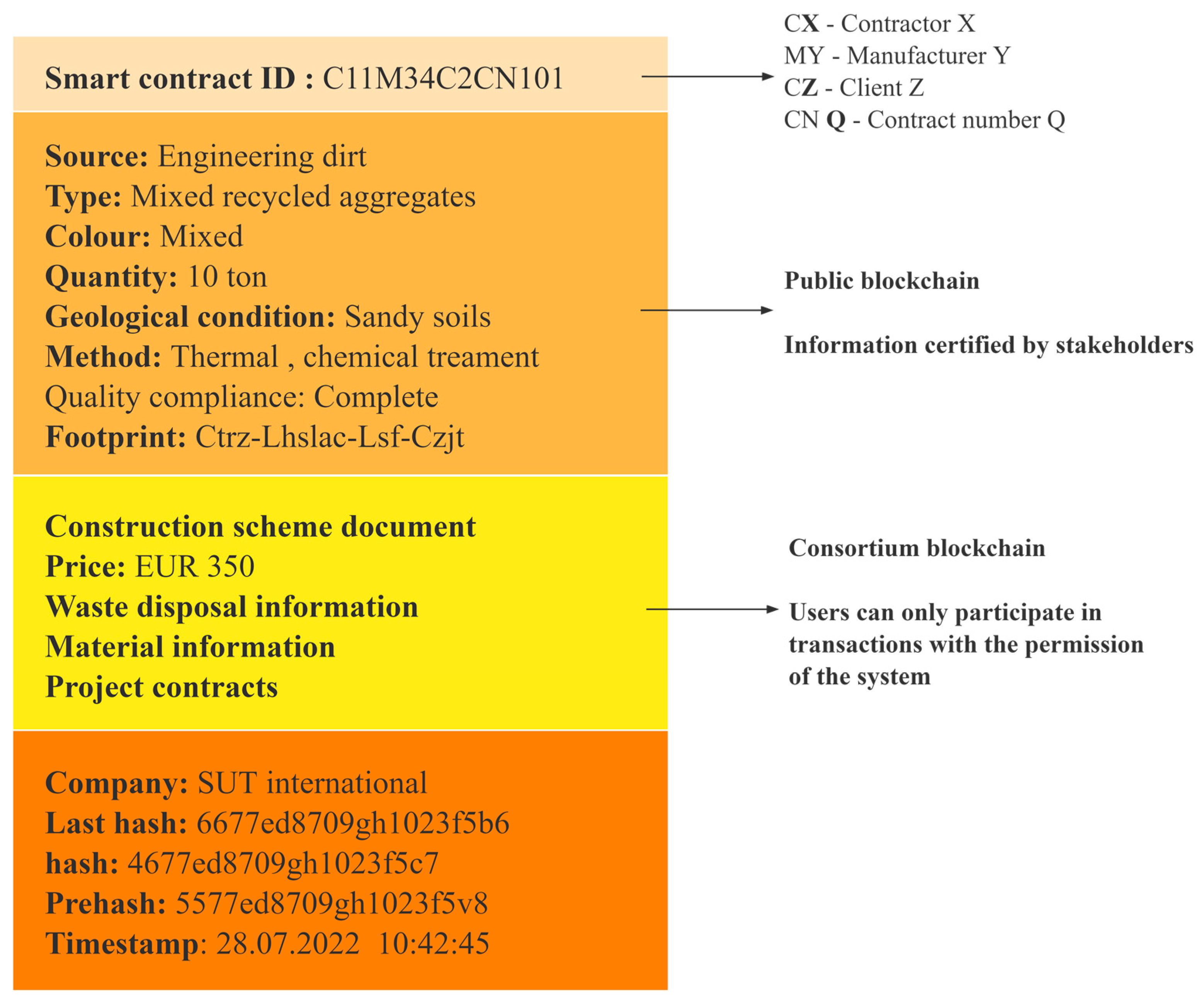
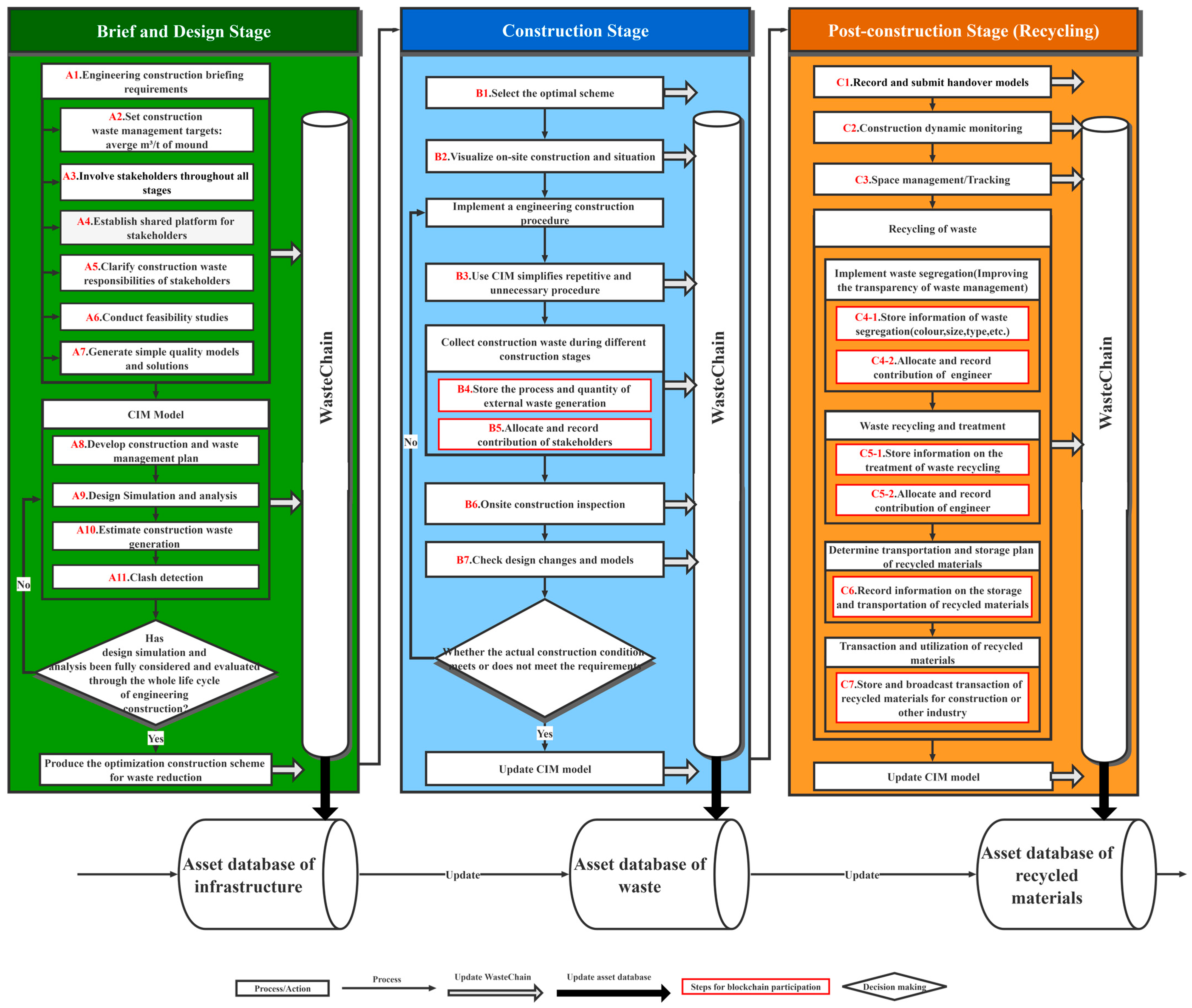
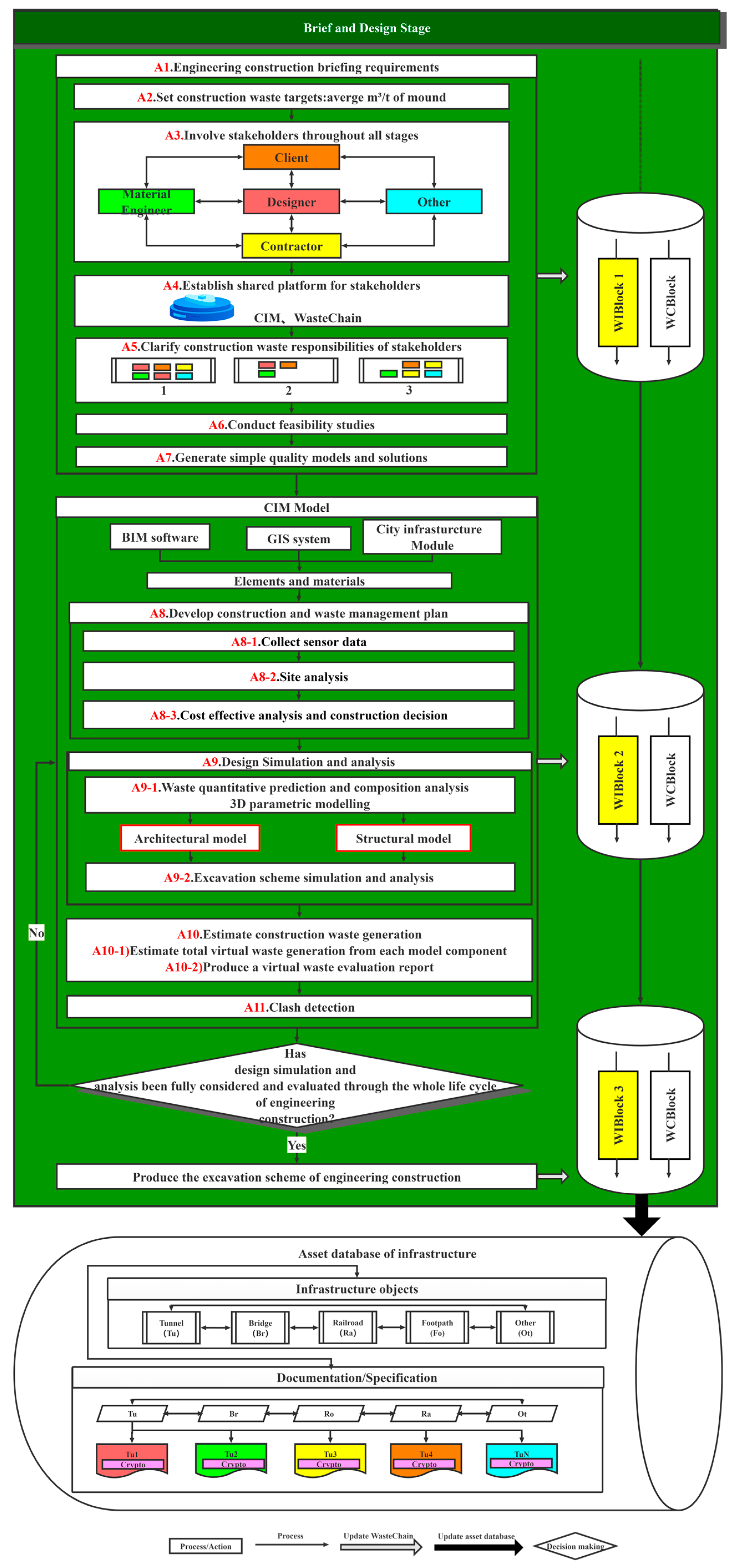
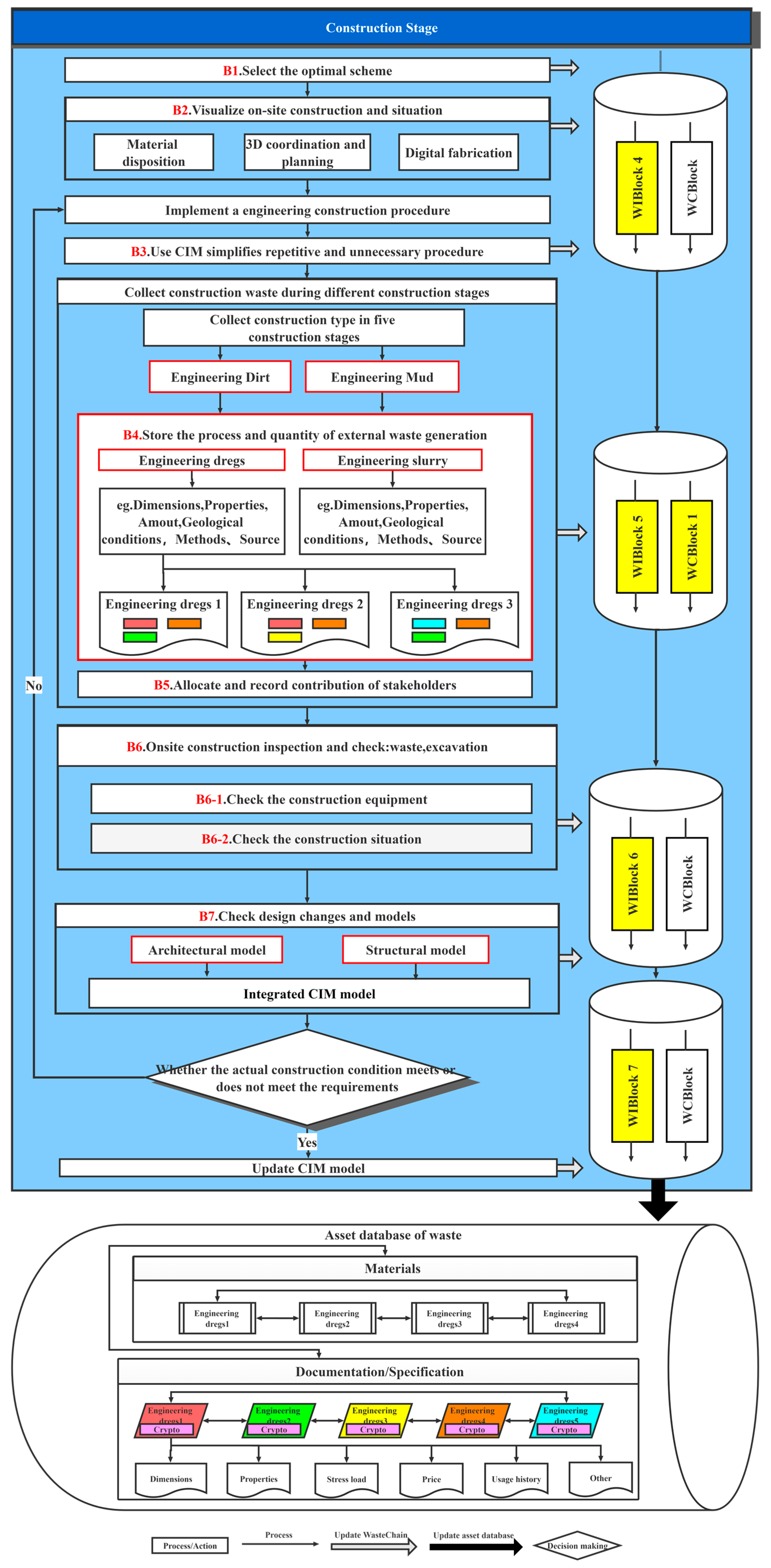



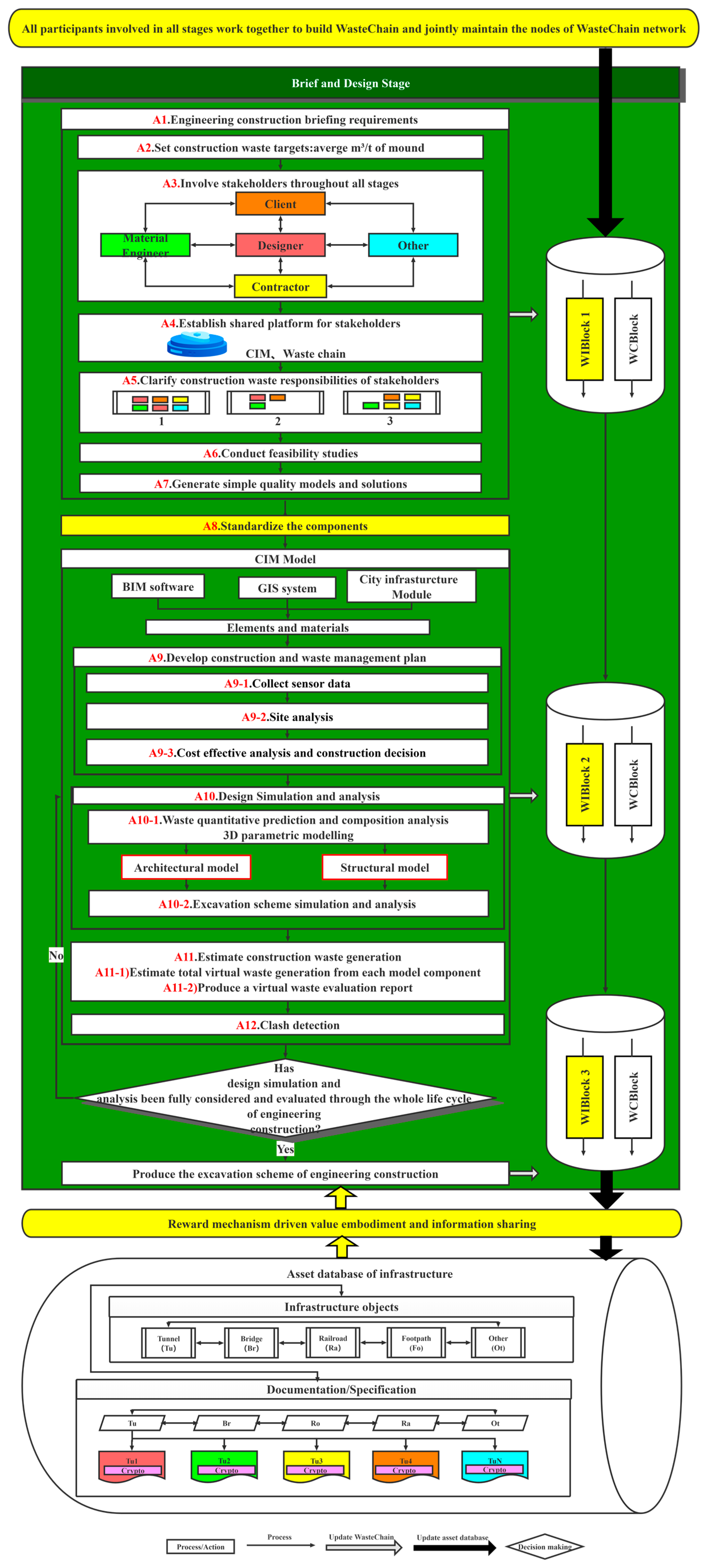
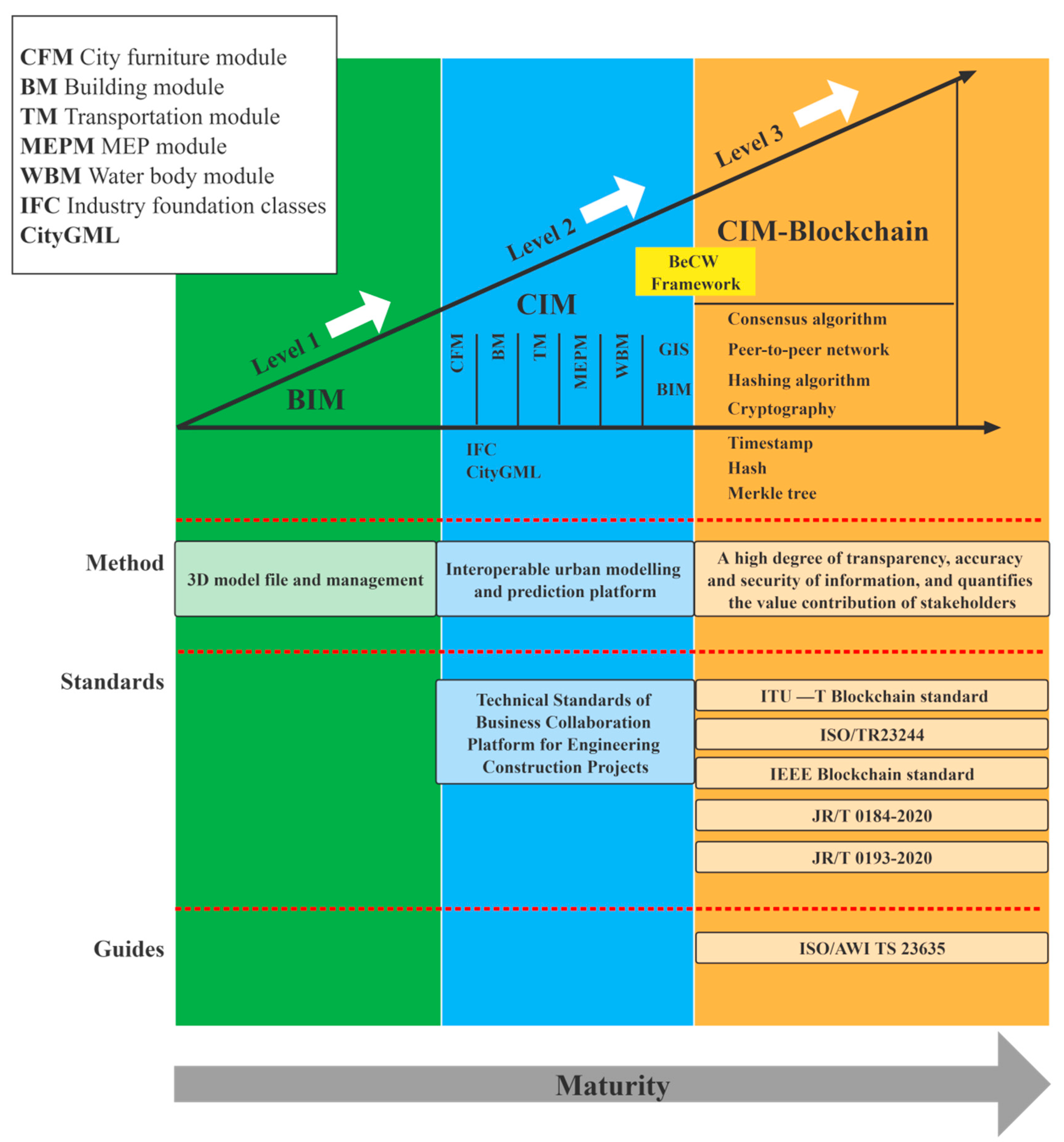
| Criteria | Purpose | Strategies Applied in This Study |
|---|---|---|
| Credibility | To guarantee the results (from the perspective of the participants) are true, credible, and believable | Ensuring the investigators had the required knowledge and research skills to perform their roles |
| Asking interviewers to send all the notes to the researcher for analysis and storage, and ensuring that the entire interview process is recorded | ||
| Prolonging and varied engagement with each setting | ||
| Dependability | To ensure the findings of this qualitative inquiry is repeatable | Preparing detailed drafts of the study protocol throughout this study |
| Developing a detailed track record of the data collection process | ||
| Measuring coding accuracy and reliability of the research team | ||
| Confirmability | To extend the trustworthiness that the results would be confirmed or corroborated by other researchers | Applying several techniques (methodological, data source, investigators and theoretical) |
| Transferability | To extend the degree to which the results can be transferred to other contexts or settings | Purposeful sampling to form a nominated sample |
| Quantifying the interview text |
| Blockchain | Read & Write Access | Consensus Process | Strengths | Limitations |
|---|---|---|---|---|
| Public blockchain | Open to all members of the network, without the need for permission from any institution | Everyone can join the consensus process | Transparency, openness, effective accountability, multi nodes | Limited transaction processing speed, high processor requirements, limited scalability |
| Private blockchain | Access within the organizer is private, only authorized users can access and read information | Nodes within a pre-selected organization | Privacy, security, high performance and efficiency | Deviation from the concept of decentralization, fewer nodes, expensive operating costs |
| Consortium blockchain | Users can only participate in transactions with the permission of the system | Pre-selected nodes in the consortium organization | High scalability, short transaction latency, efficient consistency management, moderate operating costs, privacy | Not completely decentralized |
| Advantages of Blockchain | Functions | Challenges of City Information Management (CIM) Adoption in CWM |
|---|---|---|
| Encryption of transactions and data | Data in the network are encrypted with a hash function and stored permanently | Cyber security |
| Multiple information nodes | Decentralized information is stored on different nodes, providing a basis for members in the network to share data | Data availability, accuracy, and manageability, interoperability of CIM |
| Information is transparent to all members | All users or permissioned users in the network can access the information stored in the ledger | Information asymmetry, data availability, accuracy, and manageability |
| Prevention of violations | Any violations or discrepancies will be immediately posted to the network participants | Model ownership management |
| Low risk of failure | Data information is transparent, controllable, and tamper-proof, and the value contribution of participants is attributed to the entity | Intellectual property and value distribution, model ownership management |
| Reduce human error | Any changes are reviewed by all users of the system, and algorithms in the network can identify outliers | None |
| Smart contracts | Terms and orders (e.g., tariffs, trade policies, compliance agreements) are written by coded protocols, users specify the rules of the transaction, and the computer automatically executes the contract orders | Extended responsibility and CIM Contracts |
| Synchronize transaction information | The blockchain provides a public ledger that is synchronized and updated for all users, allowing them to check past transactions at any time without relying on third parties. | Information asymmetry |
| Project Lifecycle Stages | Construction Waste Causes | Code |
|---|---|---|
| Brief and design stage | Lack of clear objectives for MCWM [10,90] | A2 |
| Design problems due to communication and collaboration difficulties between different stakeholders (e.g., architects, material engineers, and contractors) [90,91] | A3 | |
| Various interventions make design and project data exchange difficult [92] | A4 | |
| Unclear responsibility of waste [93] | A5 | |
| Lack of feasibility study for CIM application in MCWM [50] | A6 | |
| Failure to clarify project requirements [94] | A7 | |
| Lack of advanced material cost-benefit analysis based on site analysis and past data [95] | A8 | |
| Design complexity due to the difficulties of coordination and communication [96] | A9 | |
| Unpredictable virtual waste generation due to design changes, lack of space concept, and unclear material usage [97] | A10 | |
| Detect collision issues early in the design process to reduce design changes and rework in construction [50] | A11 | |
| Construction stage | Determining the best construction plan has become the most important strategic issue in MCWM [50] | B1 |
| Multiple construction requirements increase the difficulty of construction [50] | B2 | |
| Some duplicated and unnecessary construction procedures lead to a waste of resources and increased costs [98] | B3 | |
| Data loss may occur during construction data exchange [48] | B4, B5 | |
| Lack of on-site inspections and design changes leads to unnecessary procedures [99] | B6, B7 | |
| Post-construction stage | Lack of coordination and communication [90] | C1 |
| Lack of advanced predictions of hazard occurrence [50] | C2 | |
| Construction equipment and hazardous areas are difficult to search [50] | C3 | |
| Lack of a shared database, and the information is vulnerable to tampering [87,88] | C4, C5, C6, C7 |
| Characteristics | n | % |
|---|---|---|
| Gender | ||
| Male | 5 | 83.3% |
| Female | 1 | 16.7% |
| Occupation | ||
| Industry expert | 5 | 83.3% |
| University Professor | 1 | 16.7% |
| Number of years working on blockchain-related research | ||
| Less than 5 years | 0 | 0% |
| 5–10 years | 4 | 66.7% |
| 10–20 years | 2 | 33.3% |
| Over 20 years | 0 | 0% |
| Aspects | High-Level | Low-Level |
|---|---|---|
| The structure of the framework is clear | 3.67 | 3.67 |
| The content of the framework makes sense | 3.33 | 3.33 |
| The flow of the process is clear | 3.50 | 3.50 |
| Core Nodes | Number of Nodes | Interview Text (Representative Texts) |
|---|---|---|
| Strategy issues for implementation | 8 | The processing of data in the chain can be standardized, automated, and integrated, and finally forming an intelligent information network |
| Technical issues of implementation | 5 | Using distributed management to achieve data consistency, information security, and improve organizational security |
| Stakeholder issues for implementation | 3 | Stakeholders in the CIM platform in the blockchain scenario are collaborative and cooperative with each other |
| Organizational structure issues for implementation | 4 | Identify the main institutions in the chain, and consider the importance of regulators and cooperation with the government |
| Policy issues related to implementation | 4 | Data assetization requires cooperation with government and policy guidance |
| Implementation Suggestions | Academics | Industry Experts |
|---|---|---|
| Strategy issues for implementation | 21.84% | 78.16% |
| Technical issues of implementation | 39.8% | 60.2% |
| Stakeholder issues for implementation | 76.56% | 23.44% |
| Organizational structure issues for implementation | 41.4% | 58.6% |
| Policy issues related to implementation | 16.58% | 83.42% |
Publisher’s Note: MDPI stays neutral with regard to jurisdictional claims in published maps and institutional affiliations. |
© 2022 by the authors. Licensee MDPI, Basel, Switzerland. This article is an open access article distributed under the terms and conditions of the Creative Commons Attribution (CC BY) license (https://creativecommons.org/licenses/by/4.0/).
Share and Cite
Liu, Z.; Wu, T.; Wang, F.; Osmani, M.; Demian, P. Blockchain Enhanced Construction Waste Information Management: A Conceptual Framework. Sustainability 2022, 14, 12145. https://doi.org/10.3390/su141912145
Liu Z, Wu T, Wang F, Osmani M, Demian P. Blockchain Enhanced Construction Waste Information Management: A Conceptual Framework. Sustainability. 2022; 14(19):12145. https://doi.org/10.3390/su141912145
Chicago/Turabian StyleLiu, Zhen, Tzuhui Wu, Fenghong Wang, Mohamed Osmani, and Peter Demian. 2022. "Blockchain Enhanced Construction Waste Information Management: A Conceptual Framework" Sustainability 14, no. 19: 12145. https://doi.org/10.3390/su141912145
APA StyleLiu, Z., Wu, T., Wang, F., Osmani, M., & Demian, P. (2022). Blockchain Enhanced Construction Waste Information Management: A Conceptual Framework. Sustainability, 14(19), 12145. https://doi.org/10.3390/su141912145









